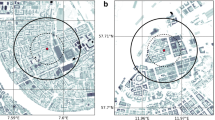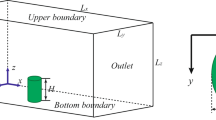Abstract
Aerodynamic roughness length (z 0m) is a key factor in surface flux estimations with remote sensing algorithms and/or land surface models. This paper calculates z 0m over several land surfaces, with 3 years of experimental data from Xiaotangshan. The results show that z 0m is direction-dependent, mainly due to the heterogeneity of the size and spatial distribution of the roughness elements inside the source area along different wind directions. Furthermore, a heuristic parameterization of the aerodynamic roughness length for heterogeneous surfaces is proposed. Individual z 0m over each surface component (patch) is calculated firstly with the characteristic parameters of the roughness elements (vegetation height, leaf area index, etc.), then z 0m over the whole experimental field is aggregated, using the footprint weighting method.
Similar content being viewed by others
References
Azevedo, P. V., and S. B. Verma, 1986: Aerodynamic characteristics of grain sorghum. Agricultural and Forestry Meteorology, 38, 193–204.
Brutsaert, W., 1982: Evaporation into the Atmosphere, Theory, History, and Applications. D.Reidel, Boston, MA., 299pp.
Businger, J. A., J. C. Wyngaard, Y. Izumi, and E. F. Bradley, 1971: Flux profile relationships in the atmospheric surface layer. J. Atmos. Sci., 28, 181–189.
Cai, X., and M. Y. Leclerc, 2007: Forward-in-time and backward-in-time dispersion in the convective boundary layer: The concentration footprint. Bound.-Layer Meteor., 123, 201–218.
Chen, J., J. Wang, and Y. Mitsuta, 1993: An independent method to determine the surface roughness length. Chinese J. Atmos. Sci., 17(1), 21–26. (in Chinese)
Choudhury, B. J., and J. L. Monteith, 1988: A four-layer model for the heat budget of homogeneous land surfaces. Quart. J. Roy. Meteor. Soc., 11, 373–398.
Dai, Y., and Coauthors, 2003: The common land model (CLM). Bull. Amer. Meteor. Soc., 84(8), 1013–1023.
Dickinson, R. E., A. Henderson-sellers, and P. J. Kennedy, 1993: Biosphere-Atmosphere Transfer Scheme (BATS) Version 1e as coupled to the NCAR Community Climate Model. National Center for Atmospheric Research (NCAR) Tech. Note, NCAR/TN-387+STR, 72pp.
Dorman, J. L., and P. J. Sellers, 1989: A global climatology of albedo, roughness length, and stomatal resistance for atmospheric general circulation models as represented by the Simple Biosphere Model (SiB). J. Appl. Meteor., 21, 833–855.
Fiedler, F., and H. A. Panofsky, 1972: The geostrophic drag coefficient and the “effective” roughness length. Quart. J. Roy. Meteor. Soc., 98, 213–221.
Garratt, J. R., 1992: The atmospheric boundary layer. Cambridge Atmospheric and Space Science Series, Cambridge University Press, Cambridge, UK, 316pp.
Hatfield, J. L., 1989: Aerodynamic properties of partial canopies. Agricultural and Forestry Meteorology, 46, 15–22.
Hiyama, T., M. Sugita, and K. Kotoda, 1996: Regional roughness parameters and momentum fluxes over a complex area. J. Appl. Meteor., 35, 2179–2190.
Jennifer, M., and W. Brusaert, 1998: Momentum roughness and view-angle dependent heat roughness at a Southern Great Plains test-site. J. Hydrol., 211, 61–68.
Jia, L., and J. Wang, 1999: The local and effective aerodynamic roughness length of a complex landscape of oasis and desert. Acta Meteorologica Sinica, 57(3), 346–357. (in Chinese)
Jia, L., and Coauthors, 2003: Estimation of sensible heat flux using the Surface Energy Balance System (SEBS) and ATSR measurements. Physics and Chemistry of the Earth, 28, 75–88.
Kormann, R., and F. X. Meixner, 2001: An analytical footprint model for non-neutral stratification. Bound.-Layer Meteor., 99, 207–224.
Kustas, W. P., B. J. Choudhury, K. E. Kunkel, and L. W. Gay, 1989: Estimate of the aerodynamic roughness parameters over an incomplete canopy cover of cotton. Agricultural and Forestry Meteorology, 46, 91–105.
Liu, S., L. Lu, D. Mao, and L. Jia, 2007a: Evaluating parameterizations of aerodynamic resistance to heat transfer using field measurements. Hydrology and Earth System Sciences, 11(2), 769–783.
Liu, S., G. Hu, L. Lu, and D. Mao, 2007b: Estimation of regional evapotranspiration by TM/ETM+ data over heterogeneous surfaces. Photogrammetric Engineering and Remote Sensing, 73(10), 1169–1178.
Massman, W., 1997: An analytical one-dimensional model of momentum transfer by vegetation of arbitrary structure. Bound.-Layer Meteor., 83, 407–421.
Mason, P. J., 1988: The formation of areally averaged roughness lengths. Quart. J. Roy. Meteor. Soc., 114, 399–420.
Marshall, J. K., 1971: Drag measurement in roughness arrays of varying density and distribution. Agricultural Meteorology, 8, 269–292.
Martano, P., 2000: Estimation of surface roughness length and displacement height from single-level sonic anemometer data. J. Appl. Meteor., 39, 708–715.
Mathias, A. D., W. P. Kustas, L. W. Gay, D. I. Cooper, L. M. Alves, and P. J. Pinter, 1990: Aerodynamic parameters for a sparsely roughened surface composed of small cotton plants and ridged soil. Remote Sens. Environ., 32, 143–153.
Menenti, M., and J. C. Ritchie, 1994: Estimation of effective aerodynamic roughness of Walnut Gulch watershed with laser altimeter measurements. Water Resources Research, 30(5), 1329–1337.
Paulson, C. A., 1970: The mathematical representation of wind speed and temperature profiles in the unstable atmospheric surface layer. J. Appl. Meteor., 9, 857–861.
Schmid, H. P., 2002: Footprint modeling for vegetation and atmosphere exchange studies: a review and perspective. Agricultural and Forest Meteorology, 113, 159–183.
Schuepp, P. H., M. Y. Leclerc, J. I. Macpherson, and R. L. Desjardins, 1990: Footprint prediction of scalar fluxes from analytical solutions of the diffusion equation. Bound.-Layer Meteor., 50, 355–373.
Shaw, R. H., and A. R. Pereira, 1982: Aerodynamic roughness of a plant canopy: a numerical experiment. Agricultural Meteorology, 26, 51–65.
Sheng, P., J. Mao, J. Li, A. Zhang, J. Sang, and N. Pan, 2003: Atmospheric Physics. Peking University Press, Beijing, 522pp. (in Chinese)
Sozzi, R., M. Favaron, and T. Georgiadis, 1998: Method for estimation of surface roughness and similarity function of wind speed vertical profile. J. Appl. Meteor., 37, 461–469.
Taylor, P. A., 1987: Comments and further analysis on effective roughness lengths for use in numerical three-dimensional models. Bound.-Layer Meteor., 39, 403–418.
Wang, H., and X. Wang, 1999: The Principles and Algorithm of Biological Boundary Layer. Meteorology Press, Beijing, 211pp. (in Chinese)
Waters, R., R. Allen, W. Bastiaanssen, M. Tasumi, and R. Trezza, 2002: Surface energy balance algorithms for land, Idaho implementation, advanced training and users manual. Version 1.0, The Idaho Department of Water Resources, 98pp.
Webb, E. K., 1970: Profile relationships: The log-linear range and extension to strong stability. Quart. J. Roy. Meteor. Soc., 96, 67–90.
Wieringa, J., 1986: Roughness-dependent geographical interpolation of surface wind speed averages. Quart. Roy. Meteor. Soc., 112, 867–889.
Yang, K., T. Koike, and D. Yang, 2003: Surface flux parameterization in the Tibetan Plateau. Bound.-Layer Meteor., 116, 245–262.
Author information
Authors and Affiliations
Corresponding author
Rights and permissions
About this article
Cite this article
Lu, L., Liu, S., Xu, Z. et al. The characteristics and parameterization of aerodynamic roughness length over heterogeneous surfaces. Adv. Atmos. Sci. 26, 180–190 (2009). https://doi.org/10.1007/s00376-009-0180-3
Received:
Revised:
Published:
Issue Date:
DOI: https://doi.org/10.1007/s00376-009-0180-3




